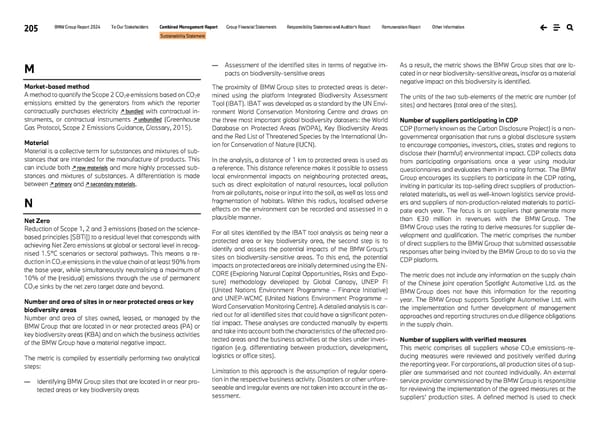205 BMW Group Report 2024 To Our Stakeholders Combined Management Report Group Financial Statements Responsibility Statement and Auditor’s Report Remuneration Report Other Information Sustainability Statement M Market-based method A method to quantify the Scope 2 CO2e emissions based on CO2e emissions emitted by the generators from which the reporter contractually purchases electricity ↗ bundled with contractual in- struments, or contractual instruments ↗ unbundled (Greenhouse Gas Protocol, Scope 2 Emissions Guidance, Glossary, 2015). Material Material is a collective term for substances and mixtures of sub- stances that are intended for the manufacture of products. This can include both ↗ raw materials and more highly processed sub- stances and mixtures of substances. A differentiation is made between ↗ primary and ↗ secondary materials. N Net Zero Reduction of Scope 1, 2 and 3 emissions (based on the science- based principles [SBTi]) to a residual level that corresponds with achieving Net Zero emissions at global or sectoral level in recog- nised 1.5°C scenarios or sectoral pathways. This means a re- duction in CO2e emissions in the value chain of at least 90% from the base year, while simultaneously neutralising a maximum of 10% of the (residual) emissions through the use of permanent CO2e sinks by the net zero target date and beyond. Number and area of sites in or near protected areas or key biodiversity areas Number and area of sites owned, leased, or managed by the BMW Group that are located in or near protected areas (PA) or key biodiversity areas (KBA) and on which the business activities of the BMW Group have a material negative impact. The metric is compiled by essentially performing two analytical steps: — Identifying BMW Group sites that are located in or near pro- tected areas or key biodiversity areas — Assessment of the identified sites in terms of negative im- pacts on biodiversity-sensitive areas The proximity of BMW Group sites to protected areas is deter- mined using the platform Integrated Biodiversity Assessment Tool (IBAT). IBAT was developed as a standard by the UN Envi- ronment World Conservation Monitoring Centre and draws on the three most important global biodiversity datasets: the World Database on Protected Areas (WDPA), Key Biodiversity Areas and the Red List of Threatened Species by the International Un- ion for Conservation of Nature (IUCN). In the analysis, a distance of 1 km to protected areas is used as a reference. This distance reference makes it possible to assess local environmental impacts on neighbouring protected areas, such as direct exploitation of natural resources, local pollution from air pollutants, noise or input into the soil, as well as loss and fragmentation of habitats. Within this radius, localised adverse effects on the environment can be recorded and assessed in a plausible manner. For all sites identified by the IBAT tool analysis as being near a protected area or key biodiversity area, the second step is to identify and assess the potential impacts of the BMW Group’s sites on biodiversity-sensitive areas. To this end, the potential impacts on protected areas are initially determined using the EN- CORE (Exploring Natural Capital Opportunities, Risks and Expo- sure) methodology developed by Global Canopy, UNEP FI (United Nations Environment Programme – Finance Initiative) and UNEP-WCMC (United Nations Environment Programme – Word Conservation Monitoring Centre). A detailed analysis is car- ried out for all identified sites that could have a significant poten- tial impact. These analyses are conducted manually by experts and take into account both the characteristics of the affected pro- tected areas and the business activities at the sites under inves- tigation (e.g. differentiating between production, development, logistics or office sites). Limitation to this approach is the assumption of regular opera- tion in the respective business activity. Disasters or other unfore- seeable and irregular events are not taken into account in the as- sessment. As a result, the metric shows the BMW Group sites that are lo- cated in or near biodiversity-sensitive areas, insofar as a material negative impact on this biodiversity is identified. The units of the two sub-elements of the metric are number (of sites) and hectares (total area of the sites). Number of suppliers participating in CDP CDP (formerly known as the Carbon Disclosure Project) is a non- governmental organisation that runs a global disclosure system to encourage companies, investors, cities, states and regions to disclose their (harmful) environmental impact. CDP collects data from participating organisations once a year using modular questionnaires and evaluates them in a rating format. The BMW Group encourages its suppliers to participate in the CDP rating, inviting in particular its top-selling direct suppliers of production- related materials, as well as well-known logistics service provid- ers and suppliers of non-production-related materials to partici- pate each year. The focus is on suppliers that generate more than €30 million in revenues with the BMW Group. The BMW Group uses the rating to derive measures for supplier de- velopment and qualification. The metric comprises the number of direct suppliers to the BMW Group that submitted assessable responses after being invited by the BMW Group to do so via the CDP platform. The metric does not include any information on the supply chain of the Chinese joint operation Spotlight Automotive Ltd. as the BMW Group does not have this information for the reporting year. The BMW Group supports Spotlight Automotive Ltd. with the implementation and further development of management approaches and reporting structures on due diligence obligations in the supply chain. Number of suppliers with verified measures This metric comprises all suppliers whose CO2e emissions-re- ducing measures were reviewed and positively verified during the reporting year. For corporations, all production sites of a sup- plier are summarised and not counted individually. An external service provider commissioned by the BMW Group is responsible for reviewing the implementation of the agreed measures at the suppliers’ production sites. A defined method is used to check
 BMW Group Report 2024 Page 204 Page 206
BMW Group Report 2024 Page 204 Page 206